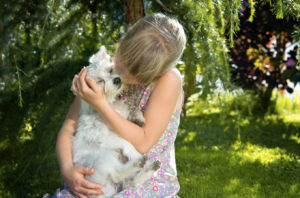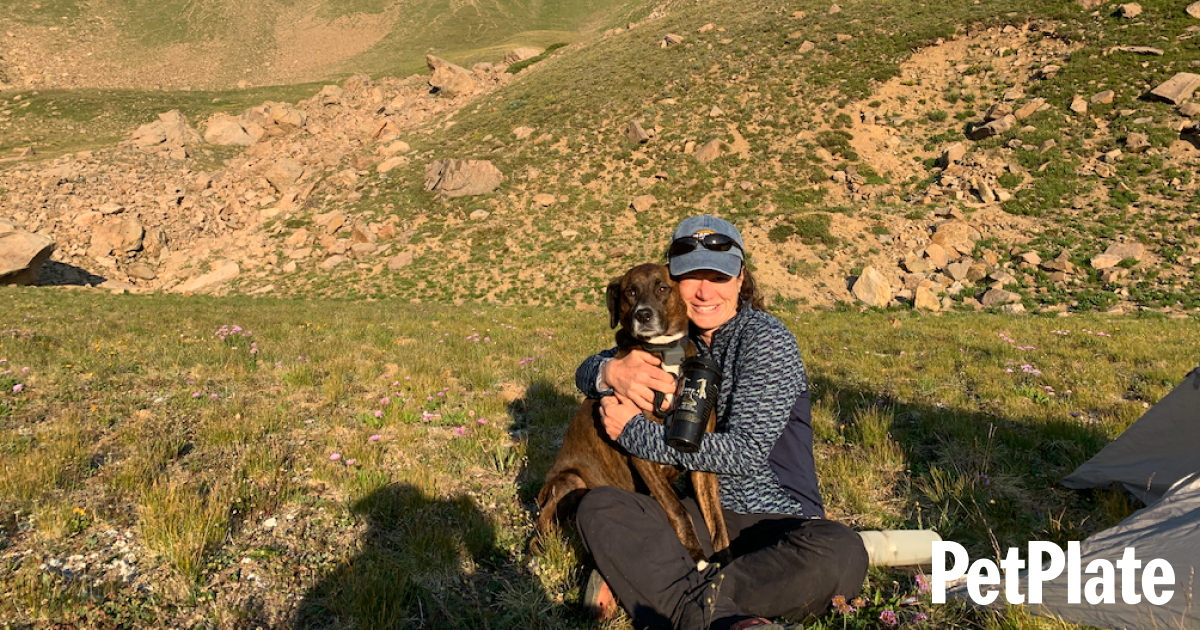
Guide to Camping With Dogs: Hiking, Hydration & Food Storage & More
What can make escaping the chaos of daily life to savor the splendor of Mother Nature even better? Your dog, of course! (And good bug spray!)
To maximize fun and safety, camping with your dog requires a bit of planning. What to bring? Where to go? Does my dog need his own sleeping bag? Is there a doggy version of s’mores? Read on for the ultimate guide to camping with pets and get ready for outdoor adventures with your best furry buddy.
_____________________________________________________________________________
Why Go Camping With Your Dog?
Camping with your pup—i.e. spending 24 hours a day together exploring new places and experiences—is not only a blast, it helps cultivate the bond between you and your dog. Add a few hikes and a bit of swimming, and you’ve got even more of what it takes to keep dogs healthy and happy. Camping is an all-you-can-sniff buffet of enrichment for dogs, providing mental and physical stimulation. Chances are, there will be other furry friends to play with at dog-friendly campgrounds, so your dog (and you!) can enjoy spending time with new pals.
Need further inspiration? Check out the Camping with Dogs website and Facebook group for endless pics of happy pups living their best lives outside.
_____________________________________________________________________________
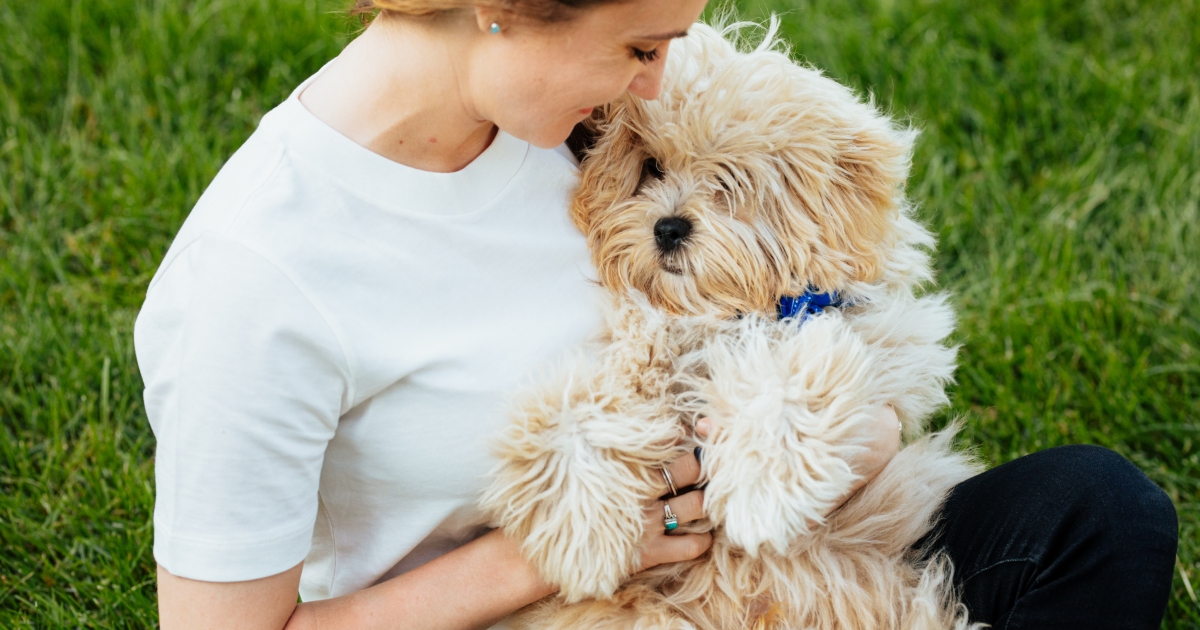
Dog Camping Gear-What Do I Need?
For a comfortable, safe camping trip, pack these dog camping essentials:
- Identification tags on a well-fitting collar. Make sure your dog’s i.d. tags are legible and secure on a collar that your pup won’t slip out of in case a squirrel, or the neighbor’s breakfast burrito, suddenly beckons. A reflective collar is handy for helping keep an eye on your dog in the dark. A light-up collar, or a clip-on dog collar light is even better. Make sure they work before you go.
- Knowledge of campgrounds rules. Many campgrounds require dogs to be leashed at all times. If so, it can be helpful to bring a tether (longer line you can attach to a tree or car) to park your pup while you relax at camp. Some dogs are fine with rope or webbing tethers. Others, who include nibbling through rope (always while nobody’s looking) in their repertoire of skills, require a chewproof tether made of rubber-covered cable to prevent them from exploring the wonders of the wild without you.
- Canine first aid kit. Include essentials like hydrogen peroxide and tweezers. Here’s a complete list from the ASPCA. Or, companies like Adventure Medical Kits and Kurgo make handy pre-packaged pet first aid packs. Don’t forget to keep an eye out for local plants that might pose a danger to your camping partner! We actually have a guide to toxic plants on our blog.
- A tent big enough for both of you. Make sure your home-away-from home has ample room for you and your adventure buddy. For dog tent camping, choose a rugged tent (especially the floor) that won’t easily rip beneath claws. Rookie canine campers will appreciate tents with mesh doors or window options that allow them to see outside with the door zipped closed.
- Beds, blankets or sleeping bags. To help ease your dog into tent life, sleep the same way you do at home. If your dog sleeps on their own bed, bring one. If they sleep on your bed, be sure your sleeping bad and pad are roomy enough (and remember how even the smallest dogs can magically expand to twice their size to take up your bed!). If it will be chilly, bring an extra blanket for them the snuggle beneath.
- Water and water bowls. Hydrating your hound is critical, so check if there is potable water available at your campsite. If not, pack lots of it in.
- Food and treats in a critter-proof container. Remember, you’re not just protecting those meals from your dog, you’re also stashing it away from hungry critters who may scurry in for a midnight snack. If you’re car camping in bear country, be sure to follow these tips for food storage. Remember, never eat or store food in your tent (and don’t forget remove any dog treats from your pockets before bed).
- Dog toys. Because chipmunks are not actually squeaky toys.
- Extra layers. If you’re heading somewhere that may get cold, especially at night, don’t forget your dog’s jacket.
- Extra poop bags and towels.
_____________________________________________________________________________
Other Nice-to-Have Items for Camping with Dogs
If you have room in your car, these items may kick your camping up a notch:
- Camping dog fence. A portable panel fencing system or playpen can keep your dog safe and let them loose the leash for a while.
- Camping dog bed. A made-for-the-outdoors bed has a better chance of lasting through through muddy pups and changing weather. Raised hammock, or cot, dog beds are great for helping dogs catch a breeze (and a snooze) above the ground.
- Dog camping chair. These lightweight, portable, low slung chairs give your dog a comfy spot as you sit sipping coffee and they sniff the delectable air.
- Camper dog house. You can find deluxe portable dog houses shaped like retro Winnebagos, but a simple weather shade may be just as useful to keep your pup comfy. Padded, weatherproof portable kennels can also make great dog campers.
______________________________________________________________________
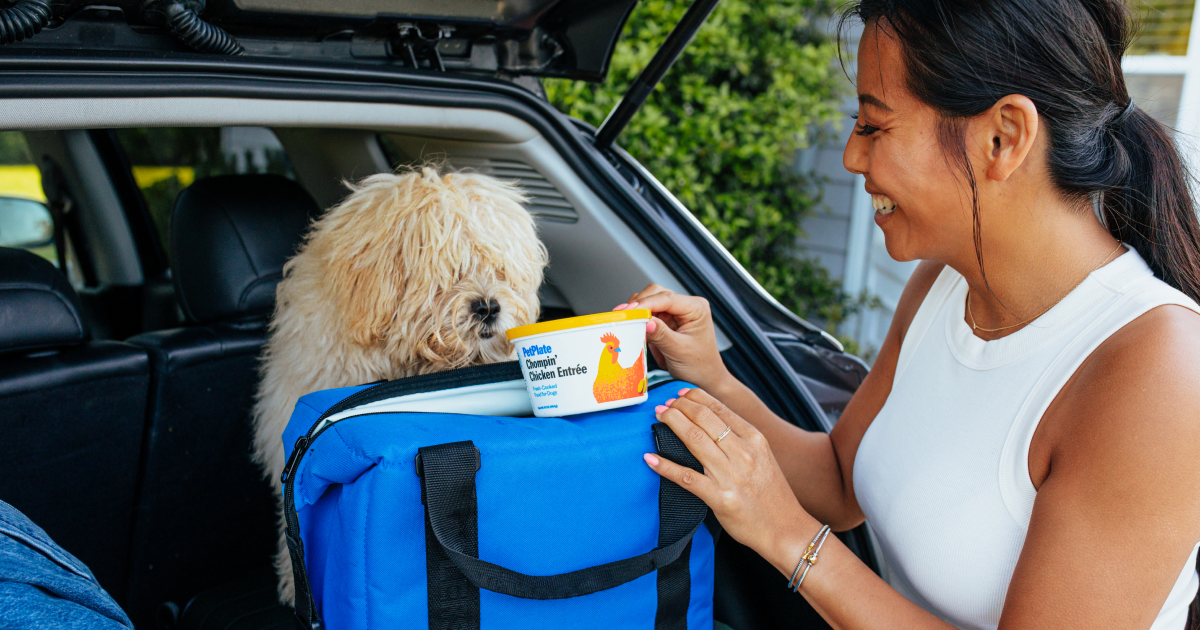
How to Store Fresh Food When Camping with Dogs
Fresh food tastes even better in the fresh air. Keeping it fresh, however, requires a bit of know-how.
PetPlate’s people-quality, kettle-simmered, veterinarian-formulated meals are conveniently packaged in recyclable containers that fit easily in coolers alongside your own provisions. If you’re lucky enough to be heading out for an extended trip, freezing a few containers to bring will serve the dual purpose of delighting your dog with healthy, delicious food to fuel their outdoor adventures and keeping your cooler cold.
Follow these tips to keep food fresh outdoors:
- Freeze or chill as much as you can before placing it in cooler.
- Add ice, preferably large blocks, which don’t melt as quickly as cubes. Make your own with reusable gallon-size freezer bags. Add the ice to your cooler hours before leaving to pre-cool it. Or, if you’ve got a giant freezer, pre-cool your empty cooler in there to maximize its chilling power.
- Pack the food that needs to stay coldest toward the bottom.
- Pack your food tightly. The tighter it’s packed (with the least air), the longer it stays cool. (Plus, you can never have too many snacks.)
- Keep the cooler out of the sun at your campsite—and remember, the shade shifts throughout the day.
- Open the cooler as little as possible.
_____________________________________________________________________________
How to Find Dog-Friendly Campgrounds
Hit the interwebs to discover campgrounds that allow dogs by Googling by location or perusing dog-friendly sites like petfriendlytravel.com (which has a state-by-state list) and gopetfriendly.com, and public resources like the National Park Service (remember, dogs are prohibited on most trails in national parks) , the Bureau of Land Management, and state park sites. Be sure to check the rules for each campsite that allows dogs, as campgrounds are all different. Take a look at our guide to favorite dog-friendly road trips for ideas!
How to Find Dog-Friendly Hikes
While the above sites are also great resources for finding dog-friendly hikes, the app AllTrails makes it even easier. The program has a filter that allows you to find hiking routes where dogs are allowed, from dog mountain hikes to leisurely streamside strolls. Be sure to check local leash regulations.
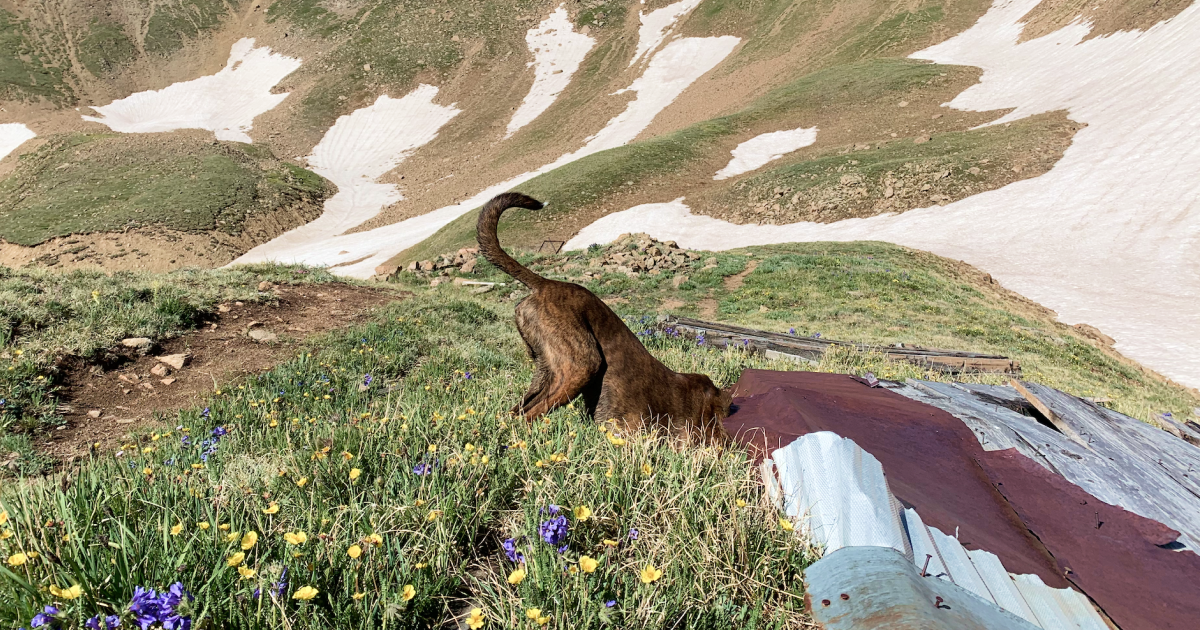
FAQ About Camping with Dogs
Still wondering how best to head to the hills (or prairies or forests or beaches) with your adventure dog? Dig in:
Is it a good idea to take a dog camping?
It is if your dog is up-to-date on all vaccines, is well-mannered on a leash (if required, or follows commands reliably if not), does well in new places and is not aggressive toward strange dogs and people. If you’re unsure, ask your vet or trainer.
Where should my dog sleep when camping?
To help ease the transition from sleeping indoors to sleeping in a tent, try to maintain your usual sleeping positions, i.e., if your dog usually sleeps in their own bed near you, bring one for them to use in the tent; or, if they usually snuggle under the covers with you, be sure to bring blankets or a big enough sleeping bag to keep everyone cozy.
Is it safe to camp in a tent with a dog?
Yes. Having your dog sleep inside the tent with you also helps muffle noises outside that may wake them and it provides a (thin) layer of separation between your dog and any nocturnal visiting varmints who come to check out your campsite.
How do I take my dog camping for the first time?
Gradually! Don’t go for a week-long stay if your dog has never been camping. Try a night or two first. Or, have a practice campout in your tent in your yard to see if your dog might enjoy camping farther afield.
How old should a dog be before going camping?
It’s best to consult your vet about your puppy’s vaccinations to see when it is safe for them to camp. Different dog breeds and sizes may receive their shots on different schedules.
_____________________________________________________________________________
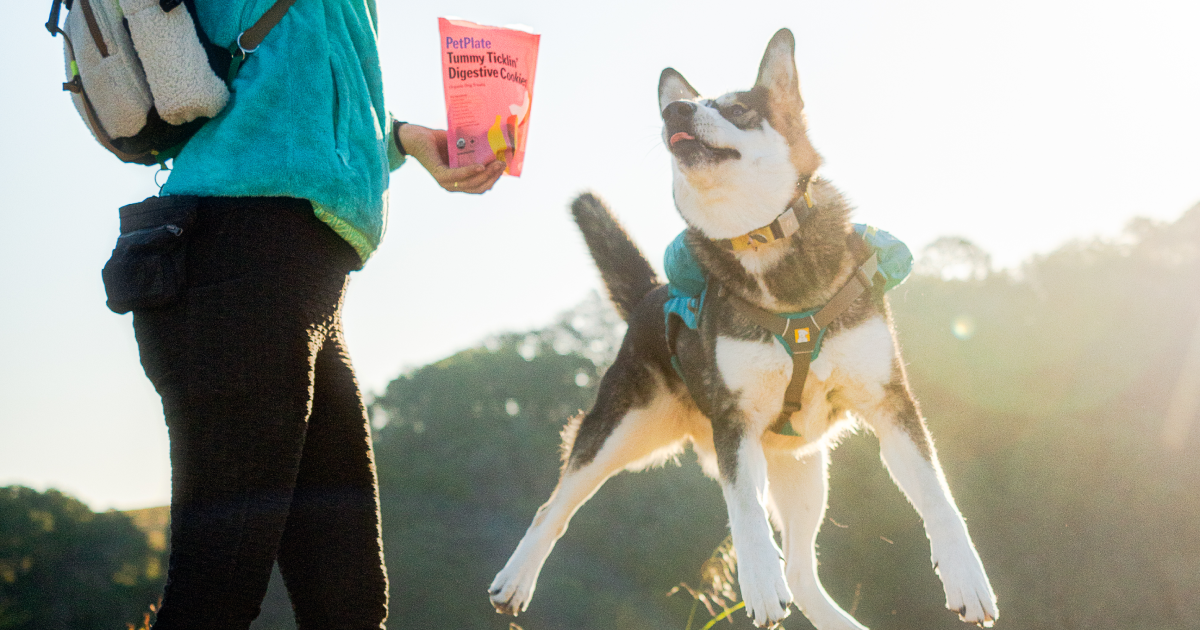
Another Camping Must-Have? Treats from PetPlate!
Ready for camping adventures with your dog? You’re now a bit savvier about the food-shelter-fetching essentials, from tents and camping beds to food storage and hiking options. Remember to plan ahead with a list of must-haves—and to check the weather report. What else is critical for a camping trip that will send your dog in zoomie circles next time you pull the tent out of your closet?
Treats, of course!
While PetPlate does not have a s’mores flavor (yet) your dog will love hanging out by the campfire (or wherever, really, because these snacks are scrumptious) with organic PetPlate Chicken Apple Sausage Bites. These chewy snacks don’t require refrigeration, making them perfect high-protein fuel for hikes—or for stargazing with your bestie. While surfing savory snack options, check out the mouth-watering (and vet-designed) fresh-cooked meals that PetPlate creates for dogs, with meal plans customized to meet your special dog’s unique nutritional needs. With convenient, pre-measured, mess-free packaging, they’re perfect for camping!
